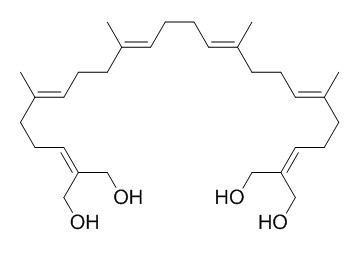Tetrahydroxysqualene
Tetrahdroxysqualene shows antimycobacterial activity with an MIC of 10.0 microg/mL, while showing only modest cytotoxicity.
Inquire / Order:
manager@chemfaces.com
Technical Inquiries:
service@chemfaces.com
Tel:
+86-27-84237783
Fax:
+86-27-84254680
Address:
1 Building, No. 83, CheCheng Rd., Wuhan Economic and Technological Development Zone, Wuhan, Hubei 430056, PRC
Providing storage is as stated on the product vial and the vial is kept tightly sealed, the product can be stored for up to
24 months(2-8C).
Wherever possible, you should prepare and use solutions on the same day. However, if you need to make up stock solutions in advance, we recommend that you store the solution as aliquots in tightly sealed vials at -20C. Generally, these will be useable for up to two weeks. Before use, and prior to opening the vial we recommend that you allow your product to equilibrate to room temperature for at least 1 hour.
Need more advice on solubility, usage and handling? Please email to: service@chemfaces.com
The packaging of the product may have turned upside down during transportation, resulting in the natural compounds adhering to the neck or cap of the vial. take the vial out of its packaging and gently shake to let the compounds fall to the bottom of the vial. for liquid products, centrifuge at 200-500 RPM to gather the liquid at the bottom of the vial. try to avoid loss or contamination during handling.
Neurotox Res.2022, 40(6):1937-1947.
Tokyo Pharmaceutical University2020, 500001431953.
J Sci Food Agric.2023, 103(1):213-220.
Mol Biol Rep.2024, 51(1):117.
Food Hydrocolloids2024, 57:110432
Pharmaceuticals (Basel).2024 Feb 24;17(3):292.
Front Pharmacol.2024, 15:1455805.
Pharmacognosy Journal, 2021, 13(5).
Am J Chin Med.2016, 44(8):1719-1735
Korean J of Medicinal Crop Science2018, 220-226
Related and Featured Products
J Nat Prod. 2008 Sep;71(9):1623-4.
Tetrahdroxysqualene from Rhus taitensis shows antimycobacterial activity against Mycobacterium tuberculosis.[Pubmed:
18710283]
Tuberculosis has become a major health problem, in particular with the emergence of extremely drug resistant tuberculosis (XDRTB).
METHODS AND RESULTS:
In our search for new therapeutic leads against TB, we isolated a new triterpene (1) from the plant Rhus taitensis collected in Papua New Guinea. Tetrahydroxysqualene (1) was isolated using bioassay-guided fractionation of the methanolic extract of R. taitensis leaves and twigs. The structure of Tetrahydroxysqualene (1) was elucidated on the basis of HRESIMS and 1D and 2D NMR spectra.
CONCLUSIONS:
Tetrahydroxysqualene (1) exhibited antituberculosis activity with an MIC of 10.0 microg/mL, while showing only modest cytotoxicity.



